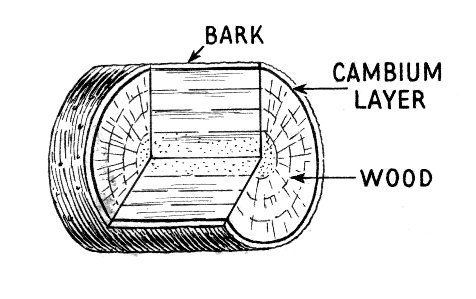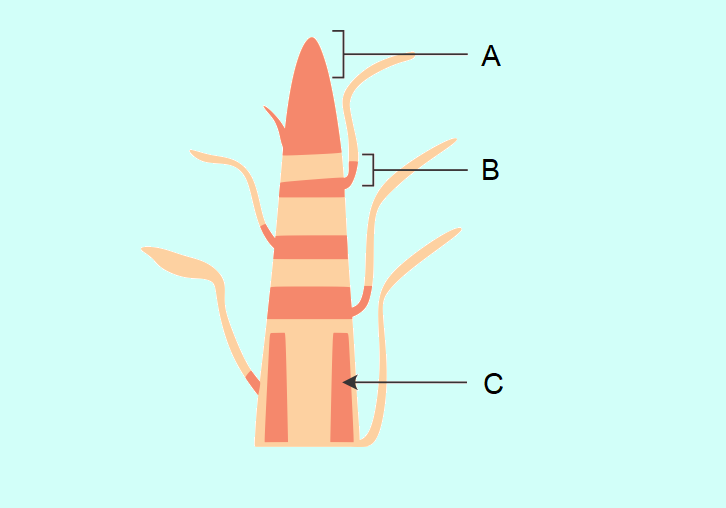9th Grade > Biology
TISSUES MCQs
Total Questions : 30
| Page 2 of 3 pages
Answer: Option B. ->
tissues
:
B
A group of cells having a common origin and co-operating with one another to perform a similar function or a set of similar functions, is described as a tissue. Some examples of tissues are muscular tissues, nervous tissues, meristematic tissues, etc.
:
B
A group of cells having a common origin and co-operating with one another to perform a similar function or a set of similar functions, is described as a tissue. Some examples of tissues are muscular tissues, nervous tissues, meristematic tissues, etc.
Answer: Option B. ->
Phloem
:
B
:
B
- Xylem and phloem are the complex permanent tissues in plants.Phloem is responsible for the movement of food manufactured in leaves to other parts of the plant.
- Xylem is involved in the conduction of minerals and water from roots to the other parts of the plants.
- Cambium (lateral meristem) is situated below the bark and is responsible for the increase in the girth of the stem or root.
- Stomata allow gaseous exchange during photosynthesis and transpiration.
Answer: Option B. ->
False
:
B
:
B
Neurons are the specialised cells of the nervous system. Each neuron has a cell body, a long axon and axon terminal. The axons bundle together to form a nerve fibre. Whereas, the muscles are made up of muscular tissue.
Answer: Option B. ->
Thin cellulosic cell wall
:
A, B, and C
Meristematic tissue is a simple tissue composed of a group of cells which can divide and produce new cells. These are small immature cells. They do not contain intercellular spaces. Their walls are thin, elastic and are made up of cellulose. They are living cells with prominent nucleus and abundant cytoplasm, and lack vacuole.

:
A, B, and C
Meristematic tissue is a simple tissue composed of a group of cells which can divide and produce new cells. These are small immature cells. They do not contain intercellular spaces. Their walls are thin, elastic and are made up of cellulose. They are living cells with prominent nucleus and abundant cytoplasm, and lack vacuole.
Answer: Option A. ->
Brain
:
A
The cells of nervous tissue are specialised for receiving stimuli and transmitting messages. Brain, spinal cord and nerves are composed of nervous tissue. The cells of this tissue are called nerve cells or neurons.
:
A
The cells of nervous tissue are specialised for receiving stimuli and transmitting messages. Brain, spinal cord and nerves are composed of nervous tissue. The cells of this tissue are called nerve cells or neurons.
Answer: Option C. ->
A: Apical meristem
B: Intercalary meristem
C: Lateral meristem
:
C
Apical meristem is present at the growing tips of stems and roots and increases the length of the stem and the root. Lateral meristem is responsible for the increase of girth (width) of the stem or root. Intercalary meristem is present at the base of the leaves or internodes (between two nodes) on twigs.
B: Intercalary meristem
C: Lateral meristem
:
C
Apical meristem is present at the growing tips of stems and roots and increases the length of the stem and the root. Lateral meristem is responsible for the increase of girth (width) of the stem or root. Intercalary meristem is present at the base of the leaves or internodes (between two nodes) on twigs.
Answer: Option A. ->
It is a type of connective tissue
:
A and C
Cartilage is a type of connective tissue. It is a soft skeletal tissue, not rigid like bone. The solid matrix of cartilage consists of water, proteins, carbohydrates and chondrin (flexible material). It is present in the joints of bones, tip of ribs, tip of nose, external ears and in trachea. The entire skeleton of shark is made of cartilage.
:
A and C
Cartilage is a type of connective tissue. It is a soft skeletal tissue, not rigid like bone. The solid matrix of cartilage consists of water, proteins, carbohydrates and chondrin (flexible material). It is present in the joints of bones, tip of ribs, tip of nose, external ears and in trachea. The entire skeleton of shark is made of cartilage.
Answer: Option C. ->
Lignin
:
C
Lignin is present in stems, around vascular bundles, in the veins of leaves and in the hard covering of seeds and nuts. It provides strength to the plant parts. It is largely a supportive structure and is part of the secondary thickening of tall plants. It is a major constituent of woody material. The cells of sclerenchyma are dead, long and narrow because their walls are thickened due to lignin. It acts as a cement and hardens them. Often these walls are so thick that there is no internal space in between the cells.
:
C
Lignin is present in stems, around vascular bundles, in the veins of leaves and in the hard covering of seeds and nuts. It provides strength to the plant parts. It is largely a supportive structure and is part of the secondary thickening of tall plants. It is a major constituent of woody material. The cells of sclerenchyma are dead, long and narrow because their walls are thickened due to lignin. It acts as a cement and hardens them. Often these walls are so thick that there is no internal space in between the cells.
Answer: Option C. ->
Xylem and phloem
:
C
Xylem and phloem together form the vascular bundle. They are called conducting tissues. Vascular or conductive tissue is a distinctive feature of the complex plants. Parenchyma, collenchyma and sclerenchyma on the other hand form the simple permanent tissue (ground tissues).
:
C
Xylem and phloem together form the vascular bundle. They are called conducting tissues. Vascular or conductive tissue is a distinctive feature of the complex plants. Parenchyma, collenchyma and sclerenchyma on the other hand form the simple permanent tissue (ground tissues).


















